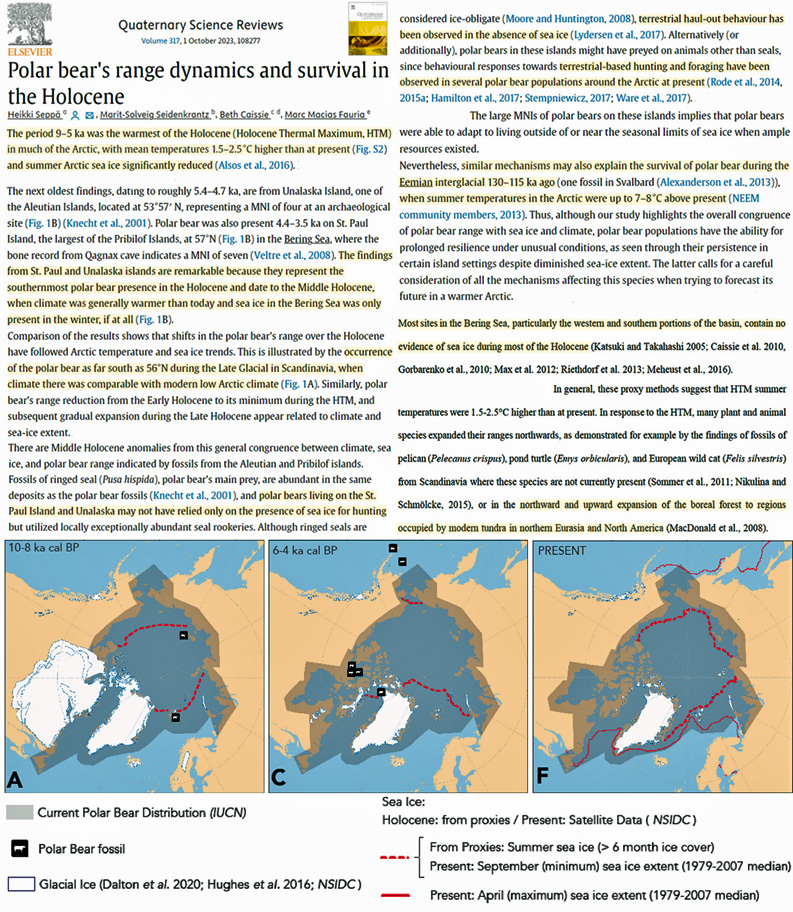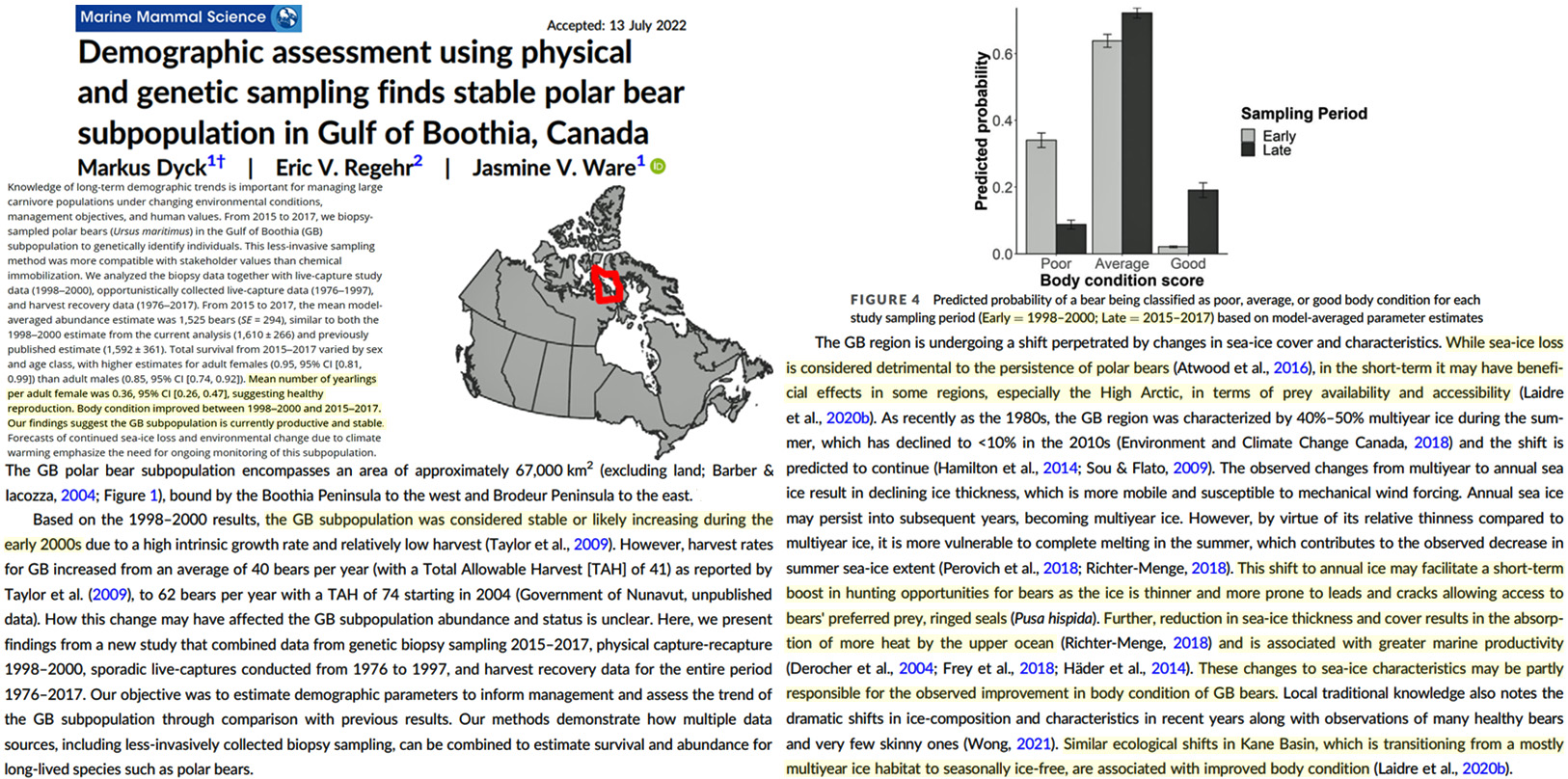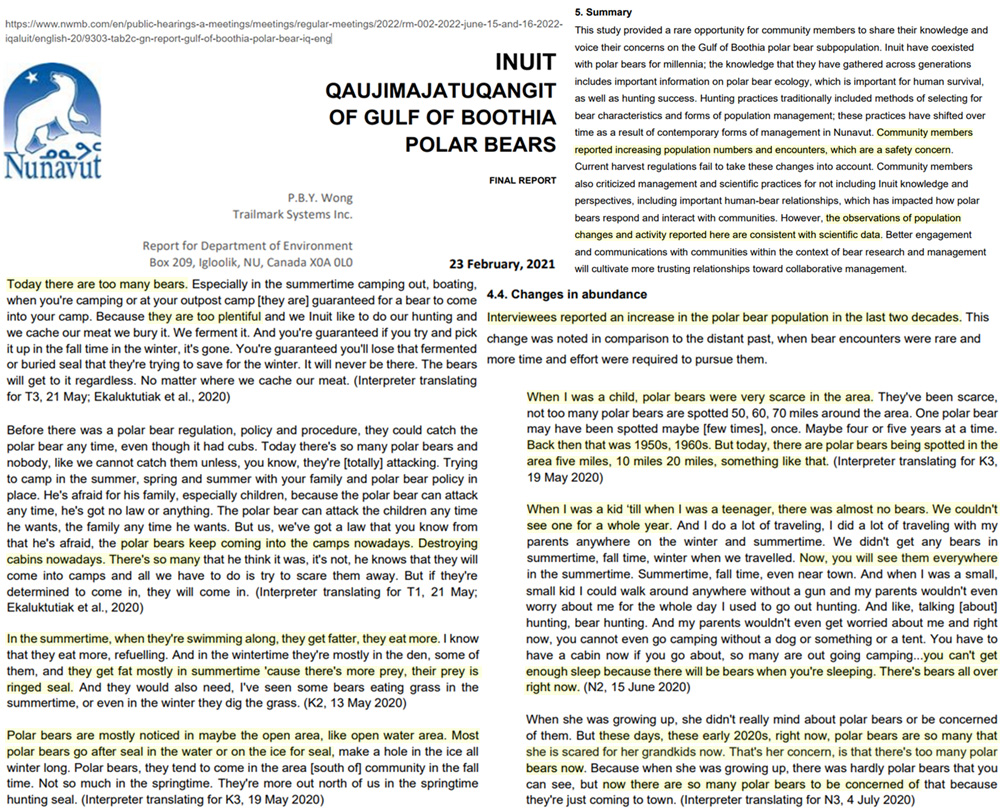Arctic regions with 6+ months of sea ice coverage today were ice-free nearly year-round 9,000 to 5,000 years ago (2°C warmer) and 130,000 to 115,000 years ago (7-8°C warmer). And yet polar bears survived these periods.
Per a new study, today’s Scandinavian Arctic climate is so cold it is actually “comparable” to that of the late last glacial.
“…the occurrence of the polar bear as far south as 56°N during the Late Glacial in Scandinavia, when climate there was comparable to with modern low [temperature] Arctic climate.”
But during the early Holocene, when it was so warm that boreal forests expanded northward to Arctic regions that are today too cold to support anything other than tundra, there was also little to no sea ice – even in winter – in regions that are today covered in sea ice throughout the autumn, winter, and spring.
“Most sites in the Bering Sea, particularly the western and southern portions of the basin, contain no evidence of sea ice during most of the Holocene.”
Scientists are increasingly admitting polar bears may not need to rely on sea ice to hunt prey, as polar bear remains can be found in regions that had little to no sea ice just a few millennia ago.
“The findings from St. Paul and Unalaska islands are remarkable because they represent the southernmost polar bear presence in the Holocene and date to the Middle Holocene, when climate was generally warmer than today and sea ice in the Bering Sea was only present in winter, if at all.”
“…polar bears living on the St. Paul Island and Unalaska may not have relied only on the presence of sea ice for hunting…”
“…terrestrial-based hunting and foraging have been observed in several polar bear populations around the Arctic at present.”
Polar bears not only survived without sea ice during the warmer Early to Middle Holocene, but also 130,000 to 115,000 years ago, when the Arctic temperatures were “up to 7-8°C above present.”

Image Source: Seppä et al., 2023
This study again exposes the falsity of the alarmist narrative that says polar bears are threatened by sea ice losses.
A 2022 study assessed the body condition of polar bears in the Gulf of Boothia – an immense 67,000 km² study region in Canada – and found they have vastly improved in the last decades.
The recent thinning ice in this region seems to have “facilitated a short-term boost in hunting opportunities for bears,” and declining ice thickness and extent “may be partly responsible for the observed improvement in body condition of GB bears.”
The subpopulation of polar bears in this region is considered “stable to likely increasing.”

Image Source: Dyck et al., 2022
Meanwhile, the native Inuit populations have been monitoring and hunting these bears for millennia and they actually observe the exact opposite of what we’ve been told by well-funded scientists.
Wong (2021) used interviews with Inuit to access the ecological knowledge of these less-sophisticated polar bear experts. The local populations report polar bears readily adapt to their surroundings and climate, and thus they routinely catch seals in open waters. They do not require sea ice to access prey. Their best body condition (“fat”) is in summer, or when sea ice is thinnest.
The polar bear populations used to be “scarce” in the 1960s and 1970s. People living in the Gulf of Boothia region could go an entire year without seeing even one. Today polar bear populations are growing so rapidly in the Gulf of Boothia that Inuit report humans – especially unarmed children – are in danger. Bears can be seen “everywhere,” and safety has become a grave local concern. The Inuit cannot sleep without fear polar bears will enter their cabins and attack their families.
The Inuit “don’t have a concern” about polar bears handling changes in sea ice extent, or adapting to nearly any environment. They don’t believe the made-up claims about polar bears going extinct due to sea ice decline.





Thank you, we will share and promote.
Some good ones there too debunking the #climatescam.
https://rclutz.com/2023/12/31/fear-not-for-arctic-ice-new-year-2024/
http://www.co2science.org
https://rforresistance.wordpress.com/2023/03/04/human-induced-climate-change-fraud-of-the-21st-century/
https://rforresistance.wordpress.com/2023/01/31/the-anthropogenic-climate-change-fraud/
[…] The Narrative That Polar Bears Need Sea Ice To Catch Prey Has Collapsed As More Evidence Piles Up […]
[…] current sea ice coverage were ice free nearly all year round between 9,000 to 5,000 years ago, and 2°C warmer than today. Furthermore it was found that temperatures were 7-8°C warmer 130,000 to 115,000 years ago. During […]
[…] current sea ice coverage were ice free nearly all year round between 9,000 to 5,000 years ago, and 2°C warmer than today. Furthermore it was found that temperatures were 7-8°C warmer 130,000 to 115,000 years ago. During […]
[…] current sea ice coverage were ice free nearly all year round between 9,000 to 5,000 years ago, and 2°C warmer than today. Furthermore it was found that temperatures were 7-8°C warmer 130,000 to 115,000 years ago. During […]
[…] marino erano libere dal ghiaccio quasi tutto l’anno tra 9.000 e 5.000 anni fa, e 2°C più calde di oggi. Inoltre, è stato riscontrato che le temperature erano di 7-8°C più calde da […]
[…] di ghiaccio marino erano libere dal ghiaccio quasi tutto l’anno tra 9.000 e 5.000 anni fa, e 2°C più calde di oggi. Inoltre, è stato riscontrato che le temperature erano di 7-8°C più calde da 130.000 a 115.000 […]
[…] di ghiaccio marino erano libere dal ghiaccio quasi tutto l’anno tra 9.000 e 5.000 anni fa, e 2°C più calde di oggi. Inoltre, è stato riscontrato che le temperature erano di 7-8°C più calde da 130.000 a 115.000 […]